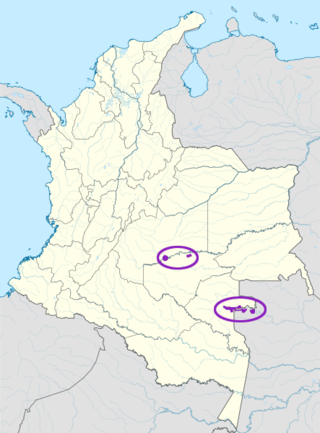| Tucano | |
|---|---|
| Dahseyé | |
| Native to | Brazil, Colombia |
| Ethnicity | Tucano people |
Native speakers | 4,600 in Brazil (2006)[1] 7,020 in Colombia (2012), including Pisamira[1] |
Tucanoan
| |
| Official status | |
Official language in | |
| Language codes | |
| ISO 639-3 | Either:tuo – Tucanoarj – Arapaso |
| Glottolog | tuca1252 Tucanoarap1275 Arapaso |
| ELP | Tukano |
| Arapaso[2] | |
 | |
Tucano, also Tukano or Tucana, endonym Dahseyé (Dasea), is a Tucanoan language spoken in Amazonas, Brazil and Colombia.
Many Tariana people, speakers of the endangered Tariana language are switching to Tucano.
Phonology
Consonants
| Bilabial | Alveolar | Palatal | Velar | Glottal | ||
|---|---|---|---|---|---|---|
| Plosive | plain | p | t | k | ʔ | |
| voiced | b | d | ɡ | |||
| Nasal | (m) | (n) | (ŋ) | |||
| Fricative | s | h | ||||
| Trill | r | |||||
| Approximant | w | j | ||||
Nasal sounds [m n ŋ] are variants of voiced stops /b d ɡ/ between nasal vowels. Stops may also be heard as prenasalized [ᵐb ⁿd ᵑɡ] after nasal vowels. /w/ can be heard as a nasal bilabial semivowel [β̞̃] in the environment of nasal vowels. Allophones of /ɾ/ can be heard as [ɾ̃], [ɺ].[3][4]
Vowels
| Front | Central | Back | |
|---|---|---|---|
| High | i ĩ | ɨ ɨ̃ | u ũ |
| Mid | e ẽ | o õ | |
| Low | a ã |
See also
References
- ^ a b Tucano at Ethnologue (25th ed., 2022)

Arapaso at Ethnologue (25th ed., 2022)
- ^ Endangered Languages Project data for Arapaso.
- ^ West, Birdie; Welch, Betty (1967). Phonemic system of Tucano. Viola G. Waterhouse (ed.), Phonemic systems of Colombian languages: Norman: Summer Institute of Linguistics of the University of Oklahoma. pp. 11–24.
- ^ Aikhenvald, 1996.
Spanish
Bibliography
- A Fala Tukano dos Ye'pâ-Masa: Tomo I: Gramática . Henri Ramirez (1997) · Manaus: Inspetoria Salesiana Missionária da Amazônia, CEDEM.
- Welch, Betty and West, Birdie (2000). In Lenguas indígenas de Colombia: una visión descriptiva edited by González de Pérez, María Stella and Rodríguez de Montes, María Luisa. Instituto Caro y Cuervo.
- Bibliografía de la familia lingüística Tukano (antes Betoya) ( pp. 79-104 ). Marcelino de Castellvi (1939). In Proceedings of the second convention of the Inter American Bibliographical and Library Association 2:2 Washington, D.C.
- Campbell, Lyle. (1997). American Indian languages: The historical linguistics of Native America. New York: Oxford University Press. ISBN 0-19-509427-1.
- Proto Tucanoan ( pp. 119-149 ). Nathan E. Waltz and Alva Wheeler (1972). In Comparative Studies in Amerindian Languages Mouton de Gruyter.
External links
- Tucanoan Languages Collection of Janet Chernela, housed at AILLA, containing audio recordings, transcriptions, translations and field notes from the 1970s and 1980s.
